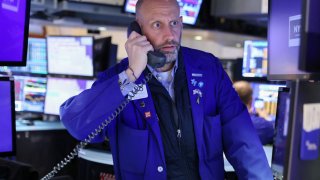
- The S&P 500 closed Monday's trade down more than 16% since the beginning of the year, and almost 12% in the second quarter alone.
- Investors have been fleeing risk assets due to a confluence of intertwining factors.
- They include persistent high inflation, slowing economic growth, the war in Ukraine, supply shocks from China and most importantly, the prospect of interest rate hikes from central banks looking to rein in consumer price increases.
Global stocks have endured a bruising week, and a difficult year so far, but some strategists believe the recent sell-off is unlikely to pave the way for a market capitulation.
The S&P 500 closed Monday's trade down more than 16% since the beginning of the year, and almost 12% in the second quarter alone. The pan-European Stoxx 600 was down more than 13% on the year by Tuesday afternoon, and the MSCI Asia Ex-Japan closed Tuesday's trade more than 16% lower.
Get Philly local news, weather forecasts, sports and entertainment stories to your inbox. Sign up for NBC Philadelphia newsletters.
Investors have been fleeing risk assets due to a confluence of intertwining factors, including persistent high inflation, slowing economic growth, the war in Ukraine, supply shocks from China and most importantly, the prospect of interest rate hikes from central banks looking to rein in consumer price increases.
However, strategists told CNBC Tuesday that there are still opportunities out there for investors to generate returns, though they may need to be more selective.
"Obviously, there's plenty of fear in the markets, there is a huge amount of volatility. I don't think we're quite at levels of full on capitulation yet, at least by the measures that we follow. I don't think we're quite into oversold territory right now," Fahad Kamal, chief investment officer at Kleinwort Hambros, told CNBC's "Squawk Box Europe."
Money Report
Kamal suggested that the mixed signals of a "reasonably strong" economic backdrop and mostly robust earnings — offset against rate rises and inflation concerns — meant it was difficult for traders to assess the likelihood of a full blown bear market emerging.
However, given the sustained and substantial rally for global stocks from their pandemic-era lows over the previous 18 months, he argued that the markets were "overdue a correction," and as such has retained a neutral position in stocks for now.
"There's plenty of reasons to think that things aren't as dire as the last few days and this year in general would suggest," Kamal said.
"One of them obviously is that we still have a robust economic paradigm. If you want a job, you can get it; if you want to raise money, you can; if you want to borrow money, albeit at slightly higher rates … you can, and those rates are still historically low."
Kamal argued, based on Kleinwort's investment modeling, that the economic regime is still reasonably attractive for long-term investors, with most economists not yet forecasting a recession, but acknowledged that stock valuations are still not cheap and momentum is "profoundly negative."
"Sentiment isn't quite at levels of full on capitulation yet. We're not there yet where people want to stampede out of the exit no matter what. There are still plenty of smaller 'buy the dip' feelings out there, at least in some parts of the market," he said.
"We do think that there is plenty of economic support still, and that's a reason why we haven't cut risk and are not sitting completely on the sidelines, because there is enough there to be supported by, particularly in terms of corporate earnings."
Central banks have had a substantial influence on market direction, with the U.S. Federal Reserve and the Bank of England raising interest rates and beginning to tighten their balance sheets as inflation runs at multi-decade highs.
The European Central Bank has yet to kickstart its hiking cycle, but has confirmed the end of its asset purchase program in the third quarter, paving the way for the cost of borrowing to rise.
Space for stock picking
Monica Defend, head of the Amundi Institute, told CNBC on Tuesday that as long as real rates – the market interest rate adjusted for inflation – continue to rise, risk assets will continue to suffer in the manner they have so far in 2022.
"It is not only about the number and size of hikes, but more to do with quantitative tightening and therefore the tightening in financial conditions and the liquidity dry-up," she added.
Like Kamal, she did not anticipate the mass exodus of investors from stock markets that would be typical of a prolonged bear market, suggesting instead that many investors would be keen to re-enter the market once volatility has moderated.
"In order to see volatility temper, the market has to price in fully the forward guidance displayed by the central banks, which is not yet the case," she explained.
Defend added that earnings may provide an "anchor" for investors, but cautioned that there is some risk of margin compression in future earnings reports as the gap between producer prices and consumer prices widens.
She suggested that while establishing a broad "top-down" approach to investing in equity markets at the moment may prove difficult, there is an opportunity for stock pickers in quality and value stocks, including financials, which may benefit from the rising rate environment.
What could go right?
Behind the turmoil in stock markets, credit and rates have also sold off in recent weeks, while the traditional safe-haven dollar has moved sharply higher, showing the prevalence of increasingly bearish sentiment in recent weeks.
Owing to this low starting point for expectations, HSBC multi-asset strategists suggested in a note Tuesday that there is scope for a sharp rally in risk assets and developed market bonds if this changes, with positioning and sentiment having nosedived of late.
However, HSBC remains "firmly risk-off" as the British lender's indicators suggest a "high chance of a growth shock in the next six months."
"Our aggregate sentiment and positioning indicator is just above the 10th percentile. Historically, levels such as this have been indicative of very positive returns for equities vs DM sovereigns or the likes of cyclical vs defensive equity sectors," HSBC Chief Multi-Asset Strategist Max Kettner said in Tuesday's note.
"The issue however is that actual positioning still seems to be quite elevated. For example,
our aggregate positioning index across a sample of real-money investors indicates that they are still net long equities and high-yield and net short duration."
This would indicate that beyond a short-term relief rally, as seen in March, the downward trajectory would be difficult to reverse without some new fundamental support from the economy, he said.






